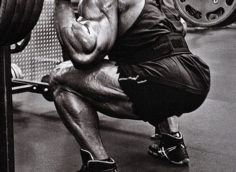To say that Charles Staley's Escalating Density Training (EDT) articles have generated a lot of interest is the understatement of the millennium... we've received hundreds of letters raving about the unusually large (and fast) gains people are making on EDT. We asked Charles if he could provide us with a specialization program utilizing EDT principles, and this is that program. As with all of EDT programs, caution is advised: EDT is already famous in training circles for the deep soreness it provokes, sometimes lasting 4-5 days post-workout. Please use appropriate precautions and follow the program to the letter as Charles recommends. Good luck!
"...arms are ready to fall off at the shoulders. Reverse grip pushdowns were completed at a dismal weight just slightly higher than my 60- year-old aunt was using when I worked in with her. (Yes, I'm serious) At 40 minutes my hands were shaking so badly I had trouble writing in my workout log. Post workout shower took 30 minutes, as I could not raise my arms to wash my hair. Outlook for tomorrow: extreme soreness has set in already, serious doubt has been cast on my ability to finish my deck as my arms probably will not look favorably on lifting those heavy 2 1/2 inch screws."
– A "fan" of EDT training
Does putting a fraction of a millimeter on your arm measurement seem about as difficult as nailing Jell-O to a wall? Have you tried everything from Lithuanian drop sets to eccentric-phase tissue remodeling with nothing to show for your efforts?
Hey – I can relate. Much like calves, putting a few millimeters of beef on your upper extremities can be a challenging task, even for highly motivated gym rats.
Well, I have good news and I have bad news. The good news is that, if there's any possibility of your peashooters turning into M-16's, I have a program that will do it. The bad news? This program will also let you know if you are cosmically ordained to look like Mr. Punyverse from the shoulder to the elbow... in other words, if your arms are capable of growing, one month of consistent and sincerely motivated EDT training will take you from potential to reality. It's that simple.
Think I'm wrong? I only ask that you measure your upper arm girth (see: The Truth About Bodybuilding Arm Measurements by Charles Poliquin for measuring tips) before you start, and then perform these 8 workouts as instructed.
Finally, re-measure your arms and YOU be the judge. When you're finished, please send an e-mail (with before & after pics if possible) to: WowMyArmsGrewLikeWeeds@MyoDynamics.com and tell me how it went. I'll share your responses with everyone in a future article.
OK, on with the nitty-gritty:
The EDT arm specialization mesocycle consists of two workouts a week, separated by 2-3 days of rest between workouts. There are no set loading parameters (see "EDT Training Procedure" below for more details) – your only objective is to gradually force feed more and more work on your bi's and tri's for 8 successive workouts. Couple this with optimal pre- and post-workout nutrition and post-workout cryotherapy, and the result is an average gain of 1/8 inch per workout. It's that simple (on paper anyway – the trick is to survive it!).
One final note of caution: In my experience, I've found it helpful to postpone any extra non-training activities for the arms for at least 3 days after each workout. In other words, usual everyday activities such as combing your hair, typing, etc., will take on a new meaning for the next month. Enjoy!
Day One
Pre-workout
500 mg Vitamin C (3-4 hours prior to workout)
One serving Power Drive (45 minutes prior to workout, and use club soda instead of water – the club soda increases stomach acidity, which increases absorption)
First 15-Minute Segment
A-1: Strict Barbell Curl
Note: From a standing position, with "soft" knees, neutral scapulae, and head/chest up, begin the curl with straight arms and bar slightly in front of your legs (not touching), pin your elbows against your torso as you curl the barbell. Keep wrists flat, and do not extend your lumbar spine (a rearward "sway" is permissible as long as you keep your spine neutral, however). Make sure your elbows reach a completely extended position between each rep, but do not allow the bar to touch your thighs or your elbows to lose contact with your torso at any time.
A-2: Supinated-Grip (palms up) Triceps Pushdowns
Note: As with the barbell curls, keep proper posture (neutral scapulae, head/chest up) and practice strict form (arms pinned against your torso, wrists flat, etc.).
B: 1/2 Serving of Surge
Second 15-Minute Segment
A-1: Incline Hammer Curl
Note: This is simply a standard hammer curl, but performed while face-down on a bench inclined to 50-60 degrees.
A-2: Seated, Overhead Dumbbell Triceps Extension
Note: This is done by supporting the inside of one end of a dumbbell with both hands.
B: 1/2 Serving of Surge
C: Ice Massage
I first learned to appreciate the value of post-workout cryotherapy from Jay Schroeder, conditioning coach for Adam Archuletta, who went on to break the NFL combines bench press record last year. Adam benched 225 pounds for 31 reps at a bodyweight of 212. I subsequently used this method on a number of athletes with great success, including Gea Johnson, who broke the track record in Park City, Utah, during last year's Olympic trials for bobsleigh. I use a cryocup from Cryo Therapy, 1-800-ICE-5722.
On each arm – just continue the massage until the cup has entirely melted. Focus on soft tissue, staying away from bones and joints. Concentrate on long, deep strokes, going parallel to the muscle fibers of the biceps, triceps, and forearms. And, yes, this feels completely miserable. All I can say is just suck it up and do it.
Day Two
Pre-workout
500 mg Vitamin C (3-4 hours prior to workout)
One serving Power Drive (45 minutes prior to workout, and use club soda instead of water)
First 15-Minute Segment
A-1: Preacher Dumbbell Curls
A-2: Decline Dumbbell Triceps Extension
Note: This is just a standard dumbbell triceps extension, but doing it from a decline position creates a unique and severe stress to the triceps.
B: 1/2 Serving of Surge
Second 15-Minute Segment
A-1: EZ-Bar Reverse Curl
A-2: Close, Reverse-Grip Bench Press
Note: Use a reverse grip and bring the bar to nipple level, and press straight up–the grip width should be such that when you perform the movement, the insides of your forearms "scrape" against your sides.)
B: 1/2 Serving of Surge
Third 15-Minute Segment:
A-1: Low-Cable Curl (left arm)
Note: This is done standing, as if you were doing a one-arm dumbbell curl. Alternate between the left arm (A-1) and the right arm (A-2).
A-2: Low-Cable Curl (right arm)
B: 1/2 Serving of Surge
C: Ice Massage
EDT Training Notes
• This is a specialization program. For a comprehensive look at how to structure your training for other bodyparts during this one-month program, please see: "Specialization Periodization" by Tony Meazell.
• Workouts should be performed twice weekly, with 2-3 days of rest between workouts (e.g., Monday, Thursday)
• EDT is based on the concept of doing more and more work from workout to workout. Therefore, it's critical that your exercise biomechanics (i.e., technique) is consistent on every workout. If you perform strict curls on one workout but use sloppy form the next, you aren't really doing more work (for the arms at least!)
• I recommend 10-15 minutes of light to moderate cardio, followed by 10-15 minutes of light stretching on "off" days for the purpose of promoting active recovery and reducing soreness.
• After warming up the first exercise(s), select a load that approximates a 10-12RM for each exercise. Ideally, the weight used for each exercise should be equally difficult.
• Each workout consists of (2-3) 15-minute time frames (and I mean EXACTLY 15 minutes – use a stopwatch or timer) separated by a short (5-minute) rest periods. In each time frame, you'll perform two exercises, for a total of 4-6 exercises per workout.
• In each time frame, the two exercises are performed in alternating fashion, back and forth, using the same weight for all sets, until the time frame has elapsed.
Sets, reps, & rest intervals: Most people will find it most productive to do higher repetition (but not maximal effort) sets and shorter rests at the beginning, and then gradually progress to less reps per set and longer rest intervals as fatigue accumulates. As an example, you might begin by performing sets of 6 with very short (15-30 second) rests. As you begin to fatigue, you'll increase your rest intervals as you drop down to sets of 4, then 2, and as the 15-minute time limit approaches, you might crank out a few singles in an effort of accomplish as many repetitions as possible in 15 minutes.
Going to failure: Do not perform early sets to failure, or even near failure. My recommended starting point is to do 1/2 of what is possible (e.g., 5 reps with a 10RM weight) at the beginning of the time frame. As the time limit approaches however, you'll find yourself working at or near failure as you attempt to break your rep record.
Progression: Each time you repeat the workout; your objective is to simply perform more total repetitions in the same time frame. As soon as you can increase the total number of reps by 20% or more, start the next workout with 5% more weight and start over.




